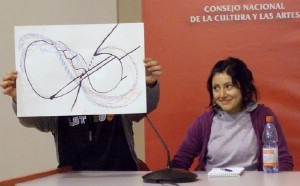
Valparaiso seems the perfect embodiment of Make the Common Precious. The port city is hardly well endowed financially, and suffers from particularly severe vertical challenges, but the people manage to give their city the feeling of a work of art in itself. The houses are painted bright primary colours. The stencil are is everywhere and most engaging. There is singing on the street and every second person seems to be carrying a guitar — I even saw a policeman with a regulation guitar over his shoulder.
 There are two artists in Valparaiso who have lived in Australia. Diogenes Farro is a ceramicist who fled the Pinochet regime and lived in Sydney for 25 years. He returned home a few years ago and has just started the first ceramics course in the school of design at University of Valparaiso. He is with Patricia Gunther, who is Director of the school of design and has implemented some very interesting teaching methods for textile students working collaboratively with the traditional weavers of Colliguay, a town in the hills just north of Valparaiso. The second ex-Australian artist is Elena Gallegos, of bountiful energy whose textile map of the world will be on display for the event on October 7.
There are two artists in Valparaiso who have lived in Australia. Diogenes Farro is a ceramicist who fled the Pinochet regime and lived in Sydney for 25 years. He returned home a few years ago and has just started the first ceramics course in the school of design at University of Valparaiso. He is with Patricia Gunther, who is Director of the school of design and has implemented some very interesting teaching methods for textile students working collaboratively with the traditional weavers of Colliguay, a town in the hills just north of Valparaiso. The second ex-Australian artist is Elena Gallegos, of bountiful energy whose textile map of the world will be on display for the event on October 7.
 One of Patricia’s students Pitti Pelacios has opened a store Design for Valparaiso in one of the many charming nooks of the city. He has developed a distinctive weaving style that is in great demand. Her weaving accentuates the unspun qualities of wool as well as the use of intensive colours, including black. Her store also stocks many other interesting Chilean clothes and jewellery designers.
One of Patricia’s students Pitti Pelacios has opened a store Design for Valparaiso in one of the many charming nooks of the city. He has developed a distinctive weaving style that is in great demand. Her weaving accentuates the unspun qualities of wool as well as the use of intensive colours, including black. Her store also stocks many other interesting Chilean clothes and jewellery designers.
 A current student is Maria los Angelos Colli, who is showing some of the work that she has been doing with the women of Colliquay. Textile artists in Chile seem to have an amazingly rich source of traditions to work with.P Perhaps there’s something here for a future Scarf Festival!
A current student is Maria los Angelos Colli, who is showing some of the work that she has been doing with the women of Colliquay. Textile artists in Chile seem to have an amazingly rich source of traditions to work with.P Perhaps there’s something here for a future Scarf Festival!





















